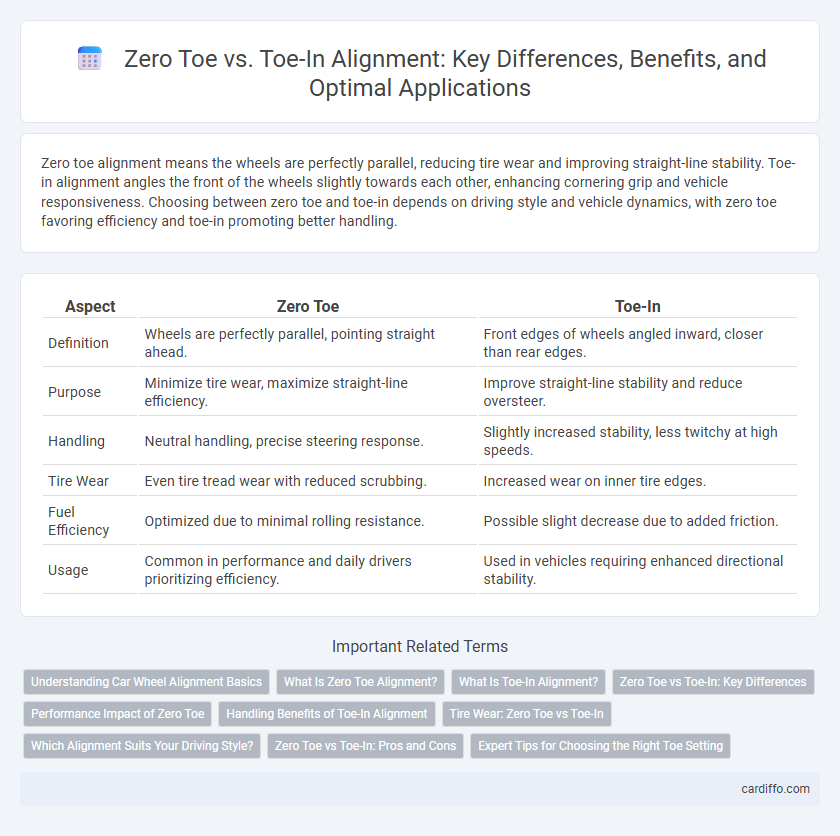Zero toe alignment means the wheels are perfectly parallel, reducing tire wear and improving straight-line stability. Toe-in alignment angles the front of the wheels slightly towards each other, enhancing cornering grip and vehicle responsiveness. Choosing between zero toe and toe-in depends on driving style and vehicle dynamics, with zero toe favoring efficiency and toe-in promoting better handling.
Table of Comparison
| Aspect | Zero Toe | Toe-In |
|---|---|---|
| Definition | Wheels are perfectly parallel, pointing straight ahead. | Front edges of wheels angled inward, closer than rear edges. |
| Purpose | Minimize tire wear, maximize straight-line efficiency. | Improve straight-line stability and reduce oversteer. |
| Handling | Neutral handling, precise steering response. | Slightly increased stability, less twitchy at high speeds. |
| Tire Wear | Even tire tread wear with reduced scrubbing. | Increased wear on inner tire edges. |
| Fuel Efficiency | Optimized due to minimal rolling resistance. | Possible slight decrease due to added friction. |
| Usage | Common in performance and daily drivers prioritizing efficiency. | Used in vehicles requiring enhanced directional stability. |
Understanding Car Wheel Alignment Basics
Zero toe alignment means the wheels are perfectly parallel to each other, promoting even tire wear and stable handling. Toe-in alignment slightly angles the front of the wheels inward, enhancing straight-line stability and reducing tire wear on certain road conditions. Understanding these fundamental differences in car wheel alignment helps optimize vehicle performance and prolong tire lifespan.
What Is Zero Toe Alignment?
Zero toe alignment refers to the condition where the wheels of a vehicle are perfectly parallel to each other, neither pointing inward (toe-in) nor outward (toe-out). This alignment setup optimizes tire wear and improves fuel efficiency by reducing rolling resistance and enhancing straight-line stability. Maintaining zero toe alignment can also contribute to better handling and prolonged tire life, making it ideal for vehicles driven primarily on smooth, straight roads.
What Is Toe-In Alignment?
Toe-in alignment occurs when the front edges of the tires point slightly toward the vehicle's centerline, enhancing straight-line stability and improving cornering response. This adjustment helps reduce tire wear by ensuring even contact with the road surface, optimizing traction and vehicle handling. Proper toe-in angles vary by vehicle type but typically range from 0.05 to 0.15 degrees for passenger cars.
Zero Toe vs Toe-In: Key Differences
Zero toe alignment positions the wheels perfectly parallel to the vehicle's centerline, minimizing tire wear and improving straight-line stability. Toe-in alignment angles the front of the wheels slightly inward, enhancing cornering grip and directional control but potentially increasing tire wear over time. Choosing between zero toe and toe-in depends on balancing tire longevity with handling performance requirements.
Performance Impact of Zero Toe
Zero toe alignment minimizes tire scrub by aligning wheels parallel to the vehicle's centerline, enhancing straight-line stability and improving fuel efficiency. This setup reduces rolling resistance and tire wear, promoting smoother handling and increased tire lifespan during high-performance driving. Unlike toe-in, which enhances cornering grip at the cost of increased tire strain, zero toe balances precision steering with minimal performance loss.
Handling Benefits of Toe-In Alignment
Toe-in alignment enhances vehicle handling by increasing front tire contact during cornering, improving stability and steering response. This adjustment reduces oversteer tendencies, providing better control on curves and during sudden maneuvers. Drivers experience increased confidence and safer handling in various driving conditions with proper toe-in settings.
Tire Wear: Zero Toe vs Toe-In
Zero toe alignment minimizes tire scrubbing and reduces uneven tire wear by keeping the wheels parallel to the vehicle's centerline. Toe-in causes the front of the tires to angle inward, leading to increased friction on the outer edges and accelerated wear patterns. Properly adjusting toe settings is crucial for extending tire lifespan and maintaining optimal vehicle handling.
Which Alignment Suits Your Driving Style?
Zero toe alignment features wheels pointing straight ahead, providing precise steering response and improved tire tread life, ideal for daily drivers seeking balanced handling. Toe-in alignment, where the front of the wheels angle slightly inward, enhances straight-line stability and reduces wander, making it suitable for high-speed highway driving and heavier vehicles. Choosing between zero toe and toe-in depends on whether you prioritize sharp cornering control or consistent straight-road stability for your driving style.
Zero Toe vs Toe-In: Pros and Cons
Zero toe alignment offers improved straight-line stability and reduced tire wear by keeping tires perfectly parallel, benefiting fuel efficiency and brake response. Toe-in enhances cornering grip and vehicle stability under acceleration by slightly angling tires inward, but may increase tire wear and reduce straight-line efficiency. Choosing between zero toe and toe-in depends on driving style, with zero toe ideal for highway driving and toe-in favored for performance handling in curves.
Expert Tips for Choosing the Right Toe Setting
Choosing the right toe setting in wheel alignment depends on vehicle type, driving conditions, and performance goals. Zero toe provides neutral handling and reduced tire wear, ideal for daily driving, while toe-in enhances straight-line stability and is preferred for heavy loads or high-speed driving. Experts recommend measuring tire wear patterns and road feedback to fine-tune toe settings, ensuring optimal grip and safety.
Zero Toe vs Toe-In Infographic

 cardiffo.com
cardiffo.com